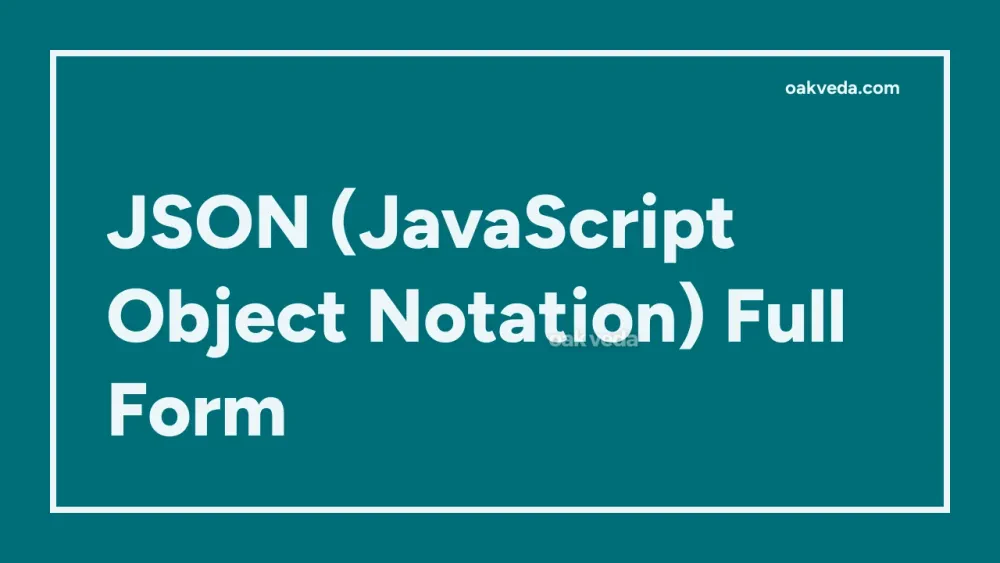
What is the Full Form of JSON?
JSON is the acronym for JavaScript Object Notation. This lightweight data interchange format has become a cornerstone of modern web development and data exchange.
What is JavaScript Object Notation?
JavaScript Object Notation, commonly known as JSON, is a text-based, language-independent data format used for storing and transmitting structured data. It's designed to be easily readable by humans and easily parsed by machines, making it an ideal choice for data exchange between web applications and servers.
Origin and Development of JSON
JSON was developed in the early 2000s by Douglas Crockford, who sought to create a simpler alternative to XML for data interchange. The format was derived from the object literal notation in JavaScript, but it quickly became language-independent. JSON was first standardized in 2013, with subsequent versions refining its specifications.
How does JSON work?
JSON works by representing data in a structured format using two primary structures:
- Objects: Enclosed in curly braces {}, containing key-value pairs
- Arrays: Enclosed in square brackets [], containing ordered lists of values
These structures can be nested to represent complex data hierarchies. JSON supports various data types, including strings, numbers, booleans, null, objects, and arrays.
Types of JSON
While JSON itself doesn't have distinct types, it's often used in different contexts:
- Simple JSON: Basic key-value pairs for straightforward data representation
- Nested JSON: Complex structures with multiple levels of objects and arrays
- JSON-LD: JSON for Linked Data, used for structured data on the web
- GeoJSON: A format for encoding geographic data structures
Functions of JSON
JSON serves several crucial functions in modern web development:
- Data Interchange: Facilitates communication between client-side and server-side applications
- Configuration: Stores application settings and preferences
- Data Storage: Used in NoSQL databases like MongoDB for flexible data schemas
- API Responses: Widely used format for delivering data from web APIs
- Data Serialization: Converts complex data structures into a string format for storage or transmission
Applications of JSON
JSON finds applications across various domains:
- Web Development: Used in RESTful APIs and AJAX requests
- Mobile App Development: For data exchange between mobile apps and servers
- IoT (Internet of Things): Lightweight format for device communication
- Data Analytics: Storing and transmitting structured data for analysis
- Cloud Computing: Configuration and data exchange in cloud services
Features of JSON
JSON boasts several features that contribute to its popularity:
- Simplicity: Easy to read and write for both humans and machines
- Lightweight: Minimal syntax overhead, reducing data transfer size
- Language Independence: Can be used with virtually any programming language
- Self-Describing: Data structure is evident from the JSON itself
- Nested Structures: Supports complex data hierarchies
- Unicode Support: Can represent a wide range of characters
Benefits of JSON
The adoption of JSON offers numerous advantages:
- Improved Performance: Faster parsing and generation compared to XML
- Broad Browser Support: Native support in modern web browsers
- Flexibility: Easily adaptable to different data structures
- Readability: Clear and intuitive format for developers
- Interoperability: Facilitates data exchange between diverse systems
- Reduced Bandwidth: Compact format minimizes data transfer size
Limitations or Challenges of JSON
Despite its strengths, JSON has some limitations:
- No Native Date Type: Dates must be stored as strings or numbers
- Limited Data Types: Doesn't support complex types like functions or regular expressions
- No Comments: Standard JSON doesn't allow comments, which can hinder documentation
- Security Concerns: Improper handling can lead to vulnerabilities like JSON injection
- No Schema Definition: Lacks built-in schema validation, unlike XML
Future Developments in JSON Technology
JSON continues to evolve to meet modern development needs:
- JSON5: An extension adding features like comments and unquoted keys
- Binary JSON (BSON): A binary-encoded serialization of JSON-like documents
- JSON Schema: A vocabulary for annotating and validating JSON documents
- JSON-RPC: A remote procedure call protocol encoded in JSON
- GraphQL: A query language for APIs that uses JSON-like syntax
FAQs on JSON Full Form
-
What does JSON stand for? JSON stands for JavaScript Object Notation.
-
Is JSON only for JavaScript? No, JSON is language-independent and can be used with most modern programming languages.
-
How does JSON compare to XML? JSON is generally more lightweight, easier to read, and faster to parse than XML.
-
Can JSON handle all data types? JSON supports strings, numbers, booleans, null, objects, and arrays, but lacks native support for dates and some complex types.
-
Is JSON secure? JSON itself is a data format and doesn't have inherent security issues, but improper handling in applications can lead to vulnerabilities.
In conclusion, JSON, or JavaScript Object Notation, has revolutionized data interchange in web development. Its simplicity, flexibility, and efficiency have made it the preferred choice for many developers and organizations. As technology evolves, JSON continues to adapt, ensuring its relevance in the ever-changing landscape of data exchange and web applications.
You may be interested in:

